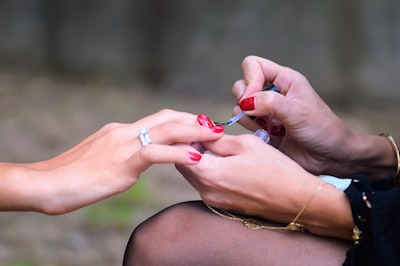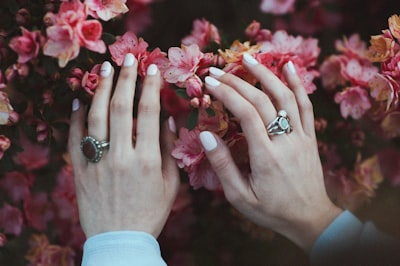Nail pain can be frustrating and uncomfortable, especially after getting them done. Various reasons can trigger it, such as physical injuries or nail infections. Our blog post discusses the causes of nail soreness, different types of pain based on the location of the nail, and why you might feel pain after getting your nails done. Join us to learn Why Do My Nails Hurt.
Why do my nails hurt?
There are various reasons why nails may hurt, such as excessive filing or buffing during a manicure, improper application of artificial nails or gel polish, or infections and allergic reactions. Allow time for your nails to recover and avoid actions that may worsen the pain.
Causes of nail soreness
Nail soreness can be a result of many factors like improper application or removal of acrylics or gel polish. Too much pressure during filing or buffing can also lead to tenderness in the nail bed. Infections such as psoriasis and allergies to certain products used in salons can cause discomfort in the surrounding skin area. Communicate any concerns with your nail technician to avoid complications like paronychia (nail infection) and swelling. Seek medical attention for severe cases.
Nail infections (paronychia)
Nail infections (paronychia) can be caused by several factors like applying too much pressure during a manicure or pedicure or an allergic reaction to nail products or chemicals. Improper nail care like cutting cuticles too deep can also lead to this condition. Symptoms include tenderness, soreness, redness, swelling and pus around the nail bed. If the severity increases it is advisable to consult a dermatologist who may prescribe antifungal medications or antibiotics.
Fungal nail infections
Over-filing or improper application of fake nails like acrylic or gel can cause fungal infections, which lead to nail pain and discomfort. Applying too much pressure while filing or buffing can also hurt the surrounding skin area around your natural nails. Avoid using a drill machine as it may cause inflammation in the nail matrix and affect keratin production resulting in thin nails naturally. Instead of self-treatment with antibiotics, try antifungal medication, or consult a dermatologist for remedies.
Ingrown nails
Ingrown nails can be painful and uncomfortable due to improper filing, harsh chemicals, or trauma during a salon visit. In severe cases, fungal infections or paronychia can cause inflammation and pus-filled swelling. Seeking medical help is advisable if the pain persists. To prevent ingrown nails, clean them regularly with warm water and use antifungal creams and antibiotics. Avoid fake nails and gel manicures, use cuticle oil for natural nails, and take iron supplements for iron deficiency.

Hangnails
Nail pain after getting them done could be due to hangnails. These occur when a piece of skin separates from the edge of a fingernail or toenail. The use of excessive force during the manicure process or harsh chemicals can cause discomfort and inflammation.
Injury to the nail bed or cuticles can also result in pain and tenderness. It’s important to communicate any discomfort with your nail technician for proper care and seek medical attention if it persists.
Physical injuries
If you experience nail pain after a manicure or pedicure session in a salon due to excessive force or the use of harsh chemicals or products that lead to injury and damage to your nails’ bed and cuticles.
Inflammation and swelling around the surrounding skin might also occur due to physical injuries. Applying warm water on the affected area can provide relief from soreness and tenderness. Make sure to communicate any discomfort with your technician and seek medical attention if pain persists.
Nail biting
After a manicure or pedicure, nail biting can lead to discomfort and pain. Overfilling or aggressively filing the nails may cause discomfort. Furthermore, chemicals used in some nail products can irritate the surrounding skin and cause irritation. Therefore, it is advised to communicate any discomfort with your nail technician and seek medical attention if necessary.
Nail abnormalities
Nail abnormalities can cause discomfort after a salon visit due to excessive filing or harsh chemicals. Underlying health conditions can also lead to discolored nails and pus-filled areas. Natural products can prevent problems, but if the issue persists, consult a dermatologist even after taking pain medication.
Pain by nail location
Pain can be experienced in various locations on the nails such as the nail bed, cuticles, or under the nails. Infections or injuries to the nail matrix could be a possible reason for pain at the nail bed. Pain around the cuticle area could also be due to rough removal techniques of cuticles or bacterial infections. Similarly tight shoes could be causing pain under nails. It is recommended to seek medical attention if discomfort persists and is not resolved with natural remedies.
Pain in the side or corner of the nail
Nails hurting at the side or corner are mostly a sign of an ingrown toenail caused by wearing tight shoes or cutting them too short. Soaking in warm water and using open-toed shoes can ease tenderness and soreness. Over-the-counter pain medication helps with any discomfort. Inflammation accompanied by pus warrants a visit to a dermatologist. In severe cases where other treatments fail, surgery may be required.
Pain in the nail bed
If you feel tenderness or soreness around your natural nail after visiting a salon, it could be due to an improper technique used by the manicurist while cleaning or filing your nails. The use of excessive acrylic or gel polish can also cause damage and discomfort at the nail bed. To avoid such issues, ensure proper hygiene and care for your nails.
In case of severe cases like pus formation and swelling, it is better to consult a dermatologist for antibiotics or antifungal medication. Total word count – 71 words. Secondary keyterms used – manicure, pedicure, salon, cuticle, polish, toenail, acrylic, warm water, swelling, psoriasis.’
Pain in the cuticles
If you experience discomfort or tenderness around your nails after a manicure at a salon, it could be due to pain in the cuticles. This can be caused by over-trimming or cutting them too close to the natural nail plate or applying harsh chemicals during cleaning or removal.
Nail hygiene is important to prevent infections like paronychia and fungal infections that might cause swelling, redness, pus-filled blisters, and joint pain. Using gentle moisturizers like cuticle oil and taking warm water soaks instead of acetone removers for removing gel polish can help relieve irritation and inflammation.
Pain after getting nails done
If you recently got your nails done and are experiencing tenderness or soreness around your nail bed, don’t panic. It’s common to feel some discomfort after a visit to the salon. The pain could be due to an allergic reaction to the products used or due to trauma caused during the procedure.
To prevent further swelling or inflammation, soak your nails in warm water mixed with antifungal agents like tea tree oil. You can also take over-the-counter pain medication if required. However, if swelling persists, consult a dermatologist immediately.
Pain when applying or removing nail polish
During the application or removal of nail polish, chemical irritation can lead to discomfort due to the use of acetone or nail polish. Occasional injuries may occur during the manicure process when nails are cut or clipped accidentally.
Allergic reactions to specific nail polish ingredients are known to cause pain and discomfort too. Additionally, lack of proper hygiene can result in both bacterial and fungal infections that may lead to soreness and pus around the surrounding skin.
Pain with acrylic nails
Acrylic nails are a popular option for those seeking long-lasting manicures. However, improper application or removal of these fake nails can lead to discomfort and pain. Pain with acrylic nails is often caused by improper nail preparation, allergies to nail glue or adhesive used in salons, fungal or bacterial infections, among other factors.
Those experiencing tenderness and swelling in the surrounding skin may find relief by cleaning their nails regularly with warm water and using antifungal treatments as prescribed by a physician. In severe cases of inflammation around the nail plate or nail matrix, it’s advisable to consult with a dermatologist.
Conclusion
Nail pain is a common and often treatable condition. Identifying the underlying cause of your nail pain can help you get relief and prevent further damage or infection. Whether it’s from an injury, an infection, or simply too tight shoes, there are many ways to alleviate the discomfort and promote healing.
In case of pain after getting nails done, try asking your technician to adjust their technique or switch to a different method that suits you better. If your nails continue to hurt after a few days, seek medical attention as it may be a sign of an infection or more severe issue. Remember, healthy nails are happy nails!





































